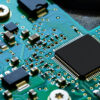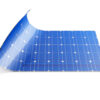
Laboratory cell demonstrates the huge potential of perovskite-based triple-junction solar cells
Researchers at the Fraunhofer Institute for Solar Energy Systems ISE have made significant strides in solar cell technology by demonstrating the potential of triple-junction solar cells. Perovskite-silicon tandem solar cells have been leading the way in achieving efficiencies of over 30 percent, representing a promising avenue for the next generation of solar cells. However, the Fraunhofer team has shown that triple-junction solar cells, comprised of perovskite-perovskite-silicon subcells, offer even greater efficiency potential than their double-junction counterparts.
As part of the Triumph research project, supported by the European Commission, and the RIESEN research project, funded by the German Federal Ministry for Economic Affairs and Climate Action, the researchers developed a triple-junction solar cell with an impressive open-circuit voltage exceeding 2.8 volts. This record-setting figure underscores the excellent material properties of the cell for electricity generation. The scientists are optimistic about the efficient solar cell architecture, emphasizing the potential of triple-junction solar cells as a notable advancement in the field.
The recent breakthrough in solar cell technology at the Fraunhofer Institute for Solar Energy Systems ISE involves triple-junction solar cells, specifically perovskite-perovskite-silicon subcells, showcasing a remarkable open-circuit voltage exceeding 2.8 volts. This achievement is particularly significant given that traditional silicon solar cells typically operate with an open-circuit voltage between 0.7 and 0.8 volts. Dr. Juliane Borchert, Group Leader for Perovskite-Silicon Technologies at Fraunhofer ISE and the University of Freiburg, emphasizes that this record-breaking voltage highlights the technology's immense promise for electricity generation.
The performance of a solar cell hinges on three key factors: open-circuit voltage, short-circuit current, and fill factor. The exceptionally high open-circuit voltage in this triple-junction solar cell suggests that its fundamental properties are conducive to creating a highly efficient solar cell. The results of this research have been published in the ACS Energy Letters journal.
While perovskite-silicon tandem solar cells have already demonstrated efficiencies exceeding 30 percent, the development of triple-junction solar cells introduces even greater potential for advancing photovoltaic concepts in the future. Prof. Dr. Stefan Glunz, Division Director for Photovoltaics at Fraunhofer ISE, underscores the significance of tandem photovoltaics for achieving higher efficiencies and notes ongoing efforts to scale up the development of perovskite-silicon tandem solar cells in the Pero-Si-SCALE project.
Read the original news item here.
Document Details and Download
- Fruaunhofer ISE
- Perovskite-Silicon Tandem Cells
- Photovoltaics Advancements
- renewable energy
- Solar Cell Technology
- Solar Energy
- Triple-Junction Solar Cells






Laboratory cell demonstrates the huge potential of perovskite-based triple-junction solar cells 0 reviews
Login to Write Your ReviewThere are no reviews yet.